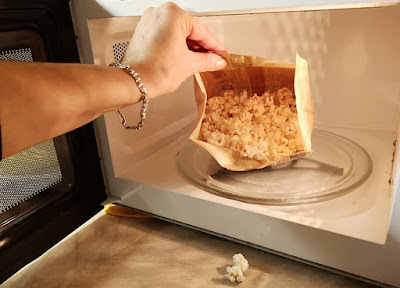The Consumerization of Popcorn... and IT
Technology continues to change not only the tools we use but the language we use to describe it. Wikipedia describes consumerization as:
…an increasingly accepted term used to describe the growing tendency for new information technology to emerge first in the consumer market and then spread into business and government organizations.
Consumerization absolutely affects technology, but confining the definition to information technology too narrowly defines it. The etymology pins the emergence of the term itself as early as 2001, which is a long time in dog years and at least a half century in technology. But the concept goes back far before Y2K. I could delve into Eli Whitney’s cotton gin, but I’ll stick to less distant history.
Before we get to IT, consider the impact of consumerization on time and choice.
Consumerization & Time
In some ways, our experiences with consumer technology have changed the very speed at which we live our lives. We don’t make time for things the way we used to. We want them now.
It’s the popcorn. OK, it’s the microwave oven. Food is both a human necessity and great motivator. The microwave changed our concept of time and convenience. We haven’t abandoned traditional cooking, but how often do you compare the conventional-oven directions to those for the microwave and think, “I want this to take 45 minutes, 3 minutes just isn’t long enough to wait”?
Popcorn showcases the evolution of our concept of time. Once upon a time, popcorn preparation was at least a 12.4-minute process, start to finish, including the ceremonial melting of butter and cleanup. Plus it required mastering the technique of keeping the pan in constant movement, carefully timing removal to optimize the number of kernels popped.
The mid-1970s arrival specialized popcorn appliances and Jiffy Pop brought popcorn faster and required less clean-up time, while largely eliminating the need for technique. Satisfaction came more quickly and with reduced effort.
And then came the microwave oven and magical little flat packages that fluffed up with aromatic salty goodness in three minutes. Clean up consisted of wiping the buttery stuff off your hands and tossing the bag in the trash. Instant gratification. Near zero effort. Our concept of time? Changed forever.
Consumerization & Choice
Consumerization has broadened our choices, allowing us more individualization. Needless to say, the concept was not yet pervasive in 1909 when Henry Ford famously said “Any customer can have a car painted any colour that he wants so long as it is black.”
Henry would spit rivets knowing a customer was in a deep dilemma between Deep Impact Blue, Gotta Have It Green, and Grabber Blue for the 11 models of the 2013 Ford Mustang.
In order for companies to meet the wallets of consumers before competitors do, they create products that meet consumer wants and needs. The myriad coffee choices once included: black, with cream, with sugar, or a radical blend of cream and sugar. Now it’s Peet’s or Starbucks, vente or large, drip or triple-shot sugar-free hazelnut soy something-or-other — multiplied by 712 variations and options.
The fast food dilemma of “hamburger or cheeseburger” has evolved to new complexities of burger variation. And chicken – broiled, fried, buffaloed. Sometimes even fish! The mind reels, the stomach roils.
Consumerization & IT
Time and choice collide when we circle back to the consumerization of IT. Time has evaporated. The days of IT-provisioned and imaged PCs are waning. Even with laptops, the “this one or that one” range of options has blossomed to include PC or Mac, then several models of each according to your job tasks.
Consider messaging. Not so long ago, we actually used paper to send messages in envelopes. A reply might take a couple of days from someone in the office; a week, maybe more, from someone in another location. Today that seems like geologic time.
E-mail was a revolution much like specialized popcorn devices. Then, this little toy we used to send smiley faces to our friends crept into the office. Not only did we co-opt instant messaging for intracompany communications, but we insisted that the vendors that created enterprise versions include emoticons. Consumerization indeed.
But that’s old stuff. Now we have web conferencing, desktop sharing, video calling. And if I call you, I expect an instant response. Our messaging app—Slack, Webex Teams, Google, take your pick—shows me you’re online, I know you’re there. Thank the microwave, time is now.
Today’s focus is on BYOD, the wonderful world of bring your own device. IT departments now deal with a seemingly logarithmically increasing number of devices, some corporate-provisioned, others employee-provided, but all with the same expectation of having the tools they need to do their jobs wherever, whenever, on whatever – that means applications, web conferencing, messaging, presence, e-mail, video. All of it.
I don’t want to carry a personal phone and a work phone, I want everything on one and I want to pick the phone I like best and have all the work apps and personal apps I need to be most productive – and amused.
And it’s not just one device. I want to use my laptop in the office, but access my secure e-mail and calendar from the third-base line at a San Francisco Giants game.
Choice: You get to choose the devices you want to use.
Time: The 9-to-5 work clock is irrelevant. Time zones are irrelevant.
Consumerization of IT: Your device has the applications you want, the cool case that makes it yours, and the picture of pet iguana on the screen. You can use your device for work and play – with the IT safeguards and policies in place to keep your company information secure, but enough flexibility so you can pop popcorn, virtually.
I originally published a version of this on blogs.cisco.com.

Comments